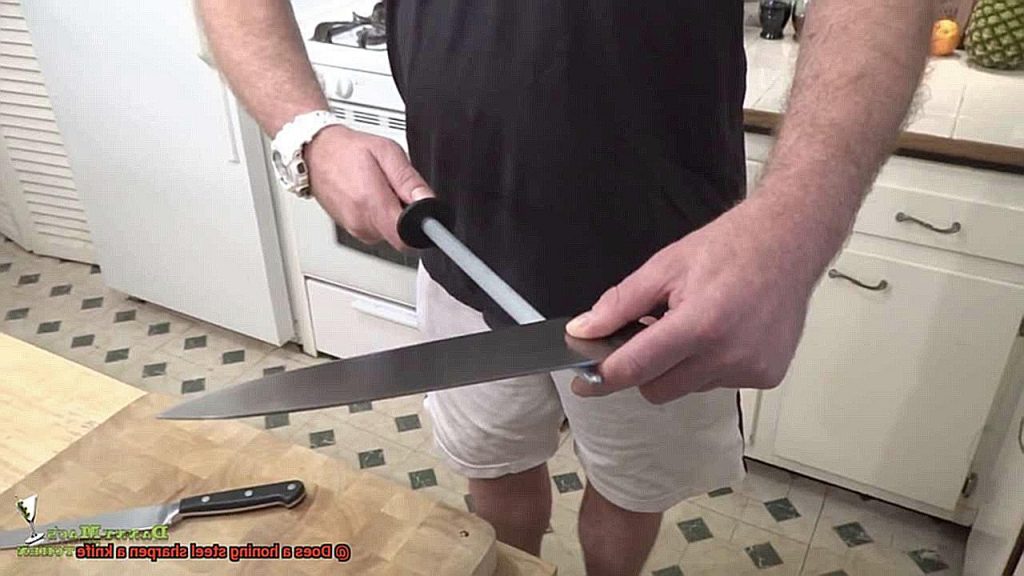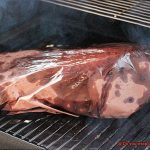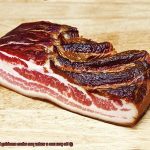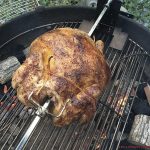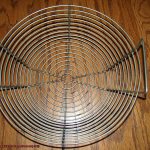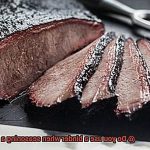Have you ever found yourself struggling to cut through a tomato with your trusty kitchen knife? It might be time to give your honing steel a closer look. The honing steel has been a go-to tool for maintaining and sharpening knives for chefs of all levels. But the question remains – does it actually sharpen a knife or just provide a temporary fix?
In this blog post, we’ll take a deep dive into the art of honing and explore the science behind the honing steel. We’ll cover different types of honing steels and their purposes, as well as techniques that home cooks and professional chefs can use to sharpen their knives with a honing steel.
But before we get into all that, let’s clear up any confusion about honing versus sharpening. Honing is the process of realigning microscopic teeth on the blade’s edge, typically done with a honing steel. Sharpening involves grinding away at the blade to create an entirely new edge. So while honing maintains sharpness, sharpening creates it anew.
Now that we’ve got that out of the way, let’s get down to business and explore whether or not a honing steel can truly sharpen a knife.
Contents
What is a Honing Steel?
Look no further than a honing steel. A honing steel, also known as a sharpening steel or honing rod, is a long, slender tool made of steel, ceramic, or diamond material that helps maintain the sharpness of your knife.
While many people believe that a honing steel can sharpen a dull knife, it actually works by realigning the blade’s edge and removing any burrs or nicks that may have developed over time. It’s important to note that a honing steel should not replace the need for actual sharpening with a whetstone or other tools.
To use a honing steel properly, hold it vertically and stationary on a sturdy surface. With the knife at a 20-degree angle, glide the blade down the steel from heel to tip in a sweeping motion. Repeat this process on the other side of the blade for about 5-10 strokes per side.
There are different types of honing steels available, each with their own unique features and benefits. Steel honing rods are the most commonly used type, but ceramic and diamond honing rods are also available. Ceramic rods are harder than steel rods and can remove more material from the blade, while diamond rods are the most abrasive and can be used for heavily damaged blades.
Choosing the correct honing steel for your knife is crucial based on the type of blade you have and how often you use it. A fine grit honing steel is best suited for maintaining an already-sharp edge, while a coarse grit is better suited for repairing damaged edges.
Does a Honing Steel Sharpen a Knife?
As any seasoned chef or home cook knows, a sharp knife is a kitchen essential. But even the best blades can lose their edge over time, requiring maintenance to ensure they perform at their best. Enter the honing steel, a trusty tool that many consider a quick fix for dull knives. But does it actually sharpen them?
The short answer is no – honing a knife with a sharpening steel does not technically sharpen it. Rather, it helps to maintain the sharpness of an already-sharp blade by realigning the edge and removing any burrs or nicks that may have formed over time. In other words, it straightens out any misalignments in the blade’s edge, improving its cutting ability.
To understand how honing works, it’s important to know the anatomy of a knife blade. A blade consists of two parts: the bevel and the edge. The bevel is the sloping part of the blade that leads up to the edge, while the edge is the thin, sharp part that does the actual cutting. With regular use, the edge can become bent or misaligned, making it less effective at slicing through food.
This is where a honing steel comes in. By running the blade along the honing steel at a specific angle, you’re essentially pushing it back into alignment with the bevel and removing any burrs or nicks that may have formed. This helps to restore its ability to cut cleanly and effectively.
However, it’s worth noting that honing alone may not be enough for extremely dull or damaged blades. In these cases, more intensive sharpening methods may be necessary to restore their sharpness. Additionally, different types of knives require different angles for honing – for example, Asian-style knives typically require a more acute angle than Western-style knives.
How to Use a Honing Steel Properly?
A honing steel is a useful tool for maintaining the sharpness of your knives, but using it correctly is crucial. Here are five sub-sections to guide you through the process of using a honing steel properly.
Grip the Honing Steel Firmly
To begin, hold the honing steel vertically with its tip resting on a stable surface. Grip the handle firmly with your non-dominant hand, ensuring that the steel stays upright and secure throughout the process.
Hold the Knife at a 20-Degree Angle
Using your dominant hand, hold the knife at a 20-degree angle against the honing steel. The blade should be angled away from you to prevent any accidents.
Draw the Knife Down and Across the Honing Steel
Starting at the base of the blade, draw the knife down and across the honing steel in a sweeping motion. Keep the blade at a consistent angle and apply light pressure to maintain control.
Repeat on the Other Side of the Blade
Once you finish honing one side of your knife, repeat the process on the other side of the blade. Make sure to maintain the same angle and pressure throughout.
Alternate Sides for Around 10 Strokes Each
After repeating steps three and four several times, alternate sides of your knife for around 10 strokes per side or until it feels properly honed.
It’s important to remember that honing doesn’t sharpen your knife; it straightens out any misalignments in the blade that can cause dullness over time. If your knife is very dull already, you may need to use a sharpening stone before honing to maintain its sharpness.
Using too much pressure while honing could cause damage to both your knife and honing steel. Moreover, using too steep of an angle may cause more harm than good. Ensure that you find the right angle for your specific knife and practice proper technique.
Benefits of Using a Honing Steel
Look no further than the honing steel. This long, cylindrical rod made of hard steel or diamond-coated metal is a simple yet essential tool for maintaining and sharpening your kitchen knives.
Contrary to popular belief, a honing steel doesn’t actually sharpen your knife by removing metal from the blade. Instead, it realigns the microscopic teeth on the blade’s edge, which become misaligned through regular use. By incorporating this simple tool into your kitchen routine, you can enjoy a range of benefits.
Here are just a few of the benefits of using a honing steel:
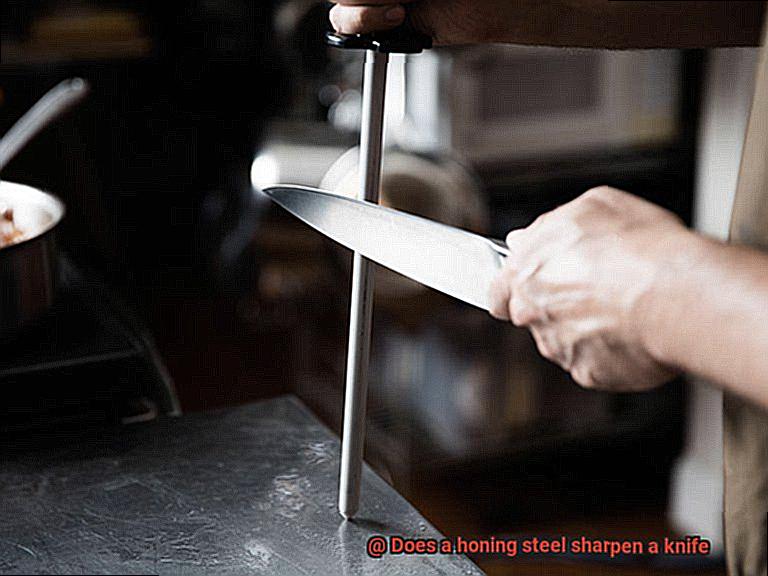
- Maintains Sharpness: Using a honing steel regularly can help keep your knives sharp and in good condition. By realigning the blade’s edge, it ensures that the knife is cutting effectively, reducing the need for frequent sharpening.
- Saves Time and Money: Frequent sharpening can be time-consuming and expensive. By using a honing steel regularly, you can prolong the life of your knife and reduce the need for professional sharpening.
- Improves Performance: A properly maintained knife will perform better than one that is not. By using a honing steel to keep your knives sharp, you can ensure that they perform at their best, making food preparation easier and more efficient.
- Prevents Accidents: Dull knives are more dangerous than sharp ones because they require more pressure to cut through food, increasing the risk of accidents. By using a honing steel to maintain sharpness, you can reduce the risk of injury in the kitchen.
Incorporating a honing steel into your kitchen routine is easy. Simply run your knife along the honing steel at a 20-degree angle, using gentle pressure and repeating on both sides. It’s recommended to do this before or after every use, depending on how frequently you use your knives.
Sharpening vs Honing: The Difference
Keeping your kitchen knives sharp is essential for efficient food preparation and a safer cooking experience. However, sharpening and honing are two distinct processes that are often confused with one another. While they may sound similar, each process serves a unique purpose in maintaining the edge of your knife.
Sharpening, as the name suggests, involves removing metal from the blade to create a new edge. This process is necessary when your knife’s edge has become dull or damaged from regular use. Sharpening can be done using a sharpening stone or an electric sharpener. These tools grind away at the metal on the blade, creating a sharp edge that is ready to tackle any task.
Honing, on the other hand, involves straightening the existing edge of your knife to maintain its sharpness. This process doesn’t remove any metal from the blade but rather helps to realign and straighten any minor imperfections or bends in the blade’s edge. Honing is typically done using a honing steel or rod with a ridged surface that allows you to run your knife along it at the correct angle.
It’s important to note that honing won’t actually sharpen a dull blade. If you notice that your knife is no longer cutting through food with ease, it’s time for a sharpening session with a sharpening stone or electric sharpener.
Regular honing and sharpening can help keep your knives in optimal condition for longer periods of time. Here are some tips to keep in mind:
- Use a honing steel or rod before each use to keep your knife’s edge straight and even.
- Sharpen your knives every few months or as needed depending on how often you use them.
- Choose high-quality sharpening stones or electric sharpeners that are suitable for your type of knife.
- Always follow the manufacturer’s instructions when using sharpeners or honing rods.
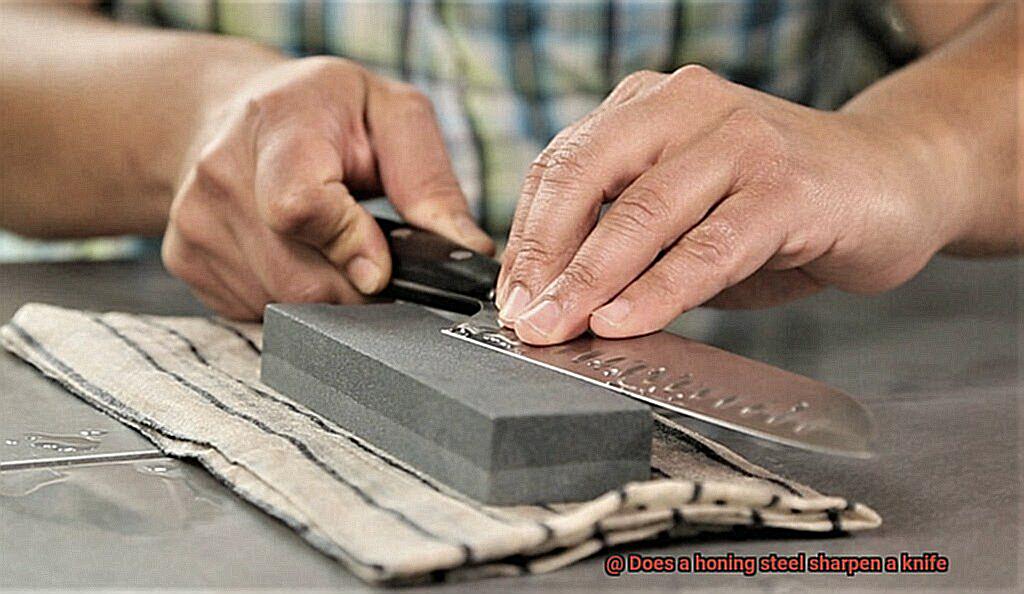
Common Misconceptions about Honing Steels
Honing steels are a crucial tool in any kitchen, but there are several misconceptions surrounding them that need to be addressed. As an expert on honing steels, I want to debunk some of the most common myths about their use.
Firstly, many people mistakenly believe that honing steels sharpen knives. However, honing is the process of realigning a knife’s edge, while sharpening involves removing metal to create a new edge. Honing should be done regularly to maintain the sharpness of the knife, while sharpening is only necessary when the knife has become dull or damaged.
Another common misconception is that honing steels can fix a dull knife. While honing can improve the sharpness of a slightly dull knife by realigning its edge, it cannot restore a severely dull or damaged blade. In such cases, sharpening is required.
It’s also important to note that not all honing steels are created equal. They come in different materials, sizes, and shapes, each with their own specific purposes. For example, ceramic honing steels are more effective at realigning the edges of harder knives, while diamond honing steels work better on softer knives.
Lastly, there is a belief that using a honing steel can damage your knives. This is only true if you don’t know how to use it correctly. Improper use of a honing steel can cause more harm than good by creating chips or dents in the blade. Therefore, it’s crucial to learn how to use a honing steel properly before attempting to hone your knife.
Different Types of Honing Steels
Honing steels are vital tools for maintaining your knives and extending their lifespan. By using them regularly and correctly, you can keep your knives in top condition and ensure that they are always ready for use.
Ceramic Honing Steels
Ceramic honing steels are made of a ceramic material and are generally harder than traditional steel honing rods. They hone and sharpen the knife’s edge, making it sharper and more precise. Additionally, ceramic honing steels are gentler on the knife’s edge than steel honing rods since they do not remove as much metal from the blade.
Diamond Honing Steels
Diamond honing steels feature diamond-coated steel rods designed to sharpen and hone knives quickly and efficiently. These honing rods are extremely durable and can sharpen even the dullest knives in just a few swipes.
Ceramic Coated Honing Steels
Ceramic coated honing steels feature steel rods coated with a layer of ceramic material. This type of honing steel provides the benefits of both ceramic and steel honing rods. The ceramic coating helps to hone and sharpen the knife’s edge, while the steel rod removes any burrs or nicks from the blade.
Steel Honing Steels
Steel honing steels are the most common type of honing rod available in the market. They come in various shapes, sizes, and materials. Steel honing steels are designed to hone and realign the blade’s edge, making it sharper and more precise.
Serrated Knife Honing Steels
Serrated knife honing steels have a rounded surface that is ideal for sharpening serrated edges without damaging the teeth of the blade. These rods are designed to hone and maintain the serrated edges of knives, keeping them sharp and precise.
Combination Honing Steels
Combination honing steels provide the benefits of multiple types of honing rods. For example, a combination honing steel could have a ceramic coating on one side and a steel rod on the other side. This type of honing steel allows you to hone and sharpen your knives with a single tool.
Tips for Maintaining Your Knives with a Honing Steel
When it comes to maintaining your knives, a honing steel is an essential tool for keeping them sharp and efficient. However, many people are confused about what a honing steel actually does. Let’s clear things up – a honing steel does not sharpen your knife, but rather it helps to realign any bent or misaligned parts of the blade that can cause dullness.
To properly use a honing steel, start by holding the steel vertically with the tip resting on a non-slip surface. Then, grip the handle of the knife and hold it at a 20-degree angle against the steel, with the blade facing away from you. Using light pressure, slide the blade down the steel while maintaining the angle, starting from the base of the blade and moving towards the tip. Repeat this process on both sides of the blade for about 8-10 strokes per side.
It’s important to note that honing should be done regularly as part of your knife maintenance routine. Waiting until your knife becomes dull can make it difficult for the honing steel to be effective. By regularly honing your knives, you can maintain their edge and keep them sharp for longer.
Using the correct honing steel for your specific type of knife is also crucial. Using an incorrect steel can cause damage to your blade and make it less effective. It’s best to consult with a professional or do some research to ensure that you are using the appropriate honing steel for your knives.
Proper storage is also essential for maintaining your knives’ sharpness and preventing damage. Use a knife block or magnetic strip, or store them in individual protective sleeves. Avoid storing knives in drawers where they can rub against other objects and become dull or damaged.
Conclusion
To maintain the sharpness of your kitchen knives, a honing steel is an indispensable tool. It works by realigning the microscopic teeth on the blade’s edge, eliminating any burrs or nicks that may have accumulated over time. However, it’s important to note that honing does not sharpen a knife – it merely preserves its sharpness.
Using a honing steel properly requires holding it vertically and stationary on a stable surface. Glide the knife blade down the steel from heel to tip in a sweeping motion at a 20-degree angle. Repeat this process on the other side of the blade for approximately 5-10 strokes per side.
Different types of honing steels are available, each with its own distinct features and benefits. Steel honing rods are the most commonly used type, but ceramic and diamond honing rods are also available. Choosing the appropriate honing steel for your knife is critical based on your blade type and frequency of use.
Regular honing and sharpening can help keep your knives in optimal condition for longer periods of time. By using them regularly and correctly, you can save time and money while improving performance in the kitchen. Always follow proper technique when using a honing steel to avoid damaging both your knife and the tool itself.
Incorporating a honing steel into your kitchen routine is simple and advantageous – just ensure that you choose one that meets your requirements and use it frequently for optimal outcomes.

